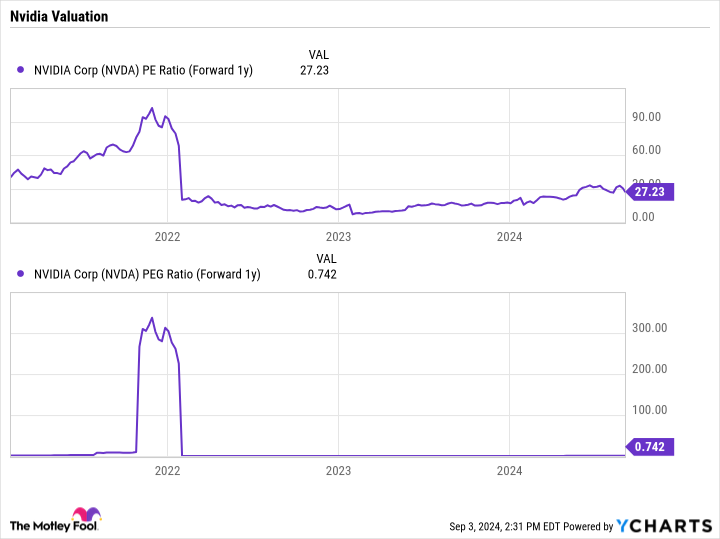CashNews.co
Nvidia (NASDAQ: NVDA) has been one of the best-performing stocks over the past five years, up an astonishing 2,430%. Given those gains, the question many investors ask now is whether it is too late for new investors to buy in and see above-average returns.
Let’s look at four reasons why Nvidia stock is still worth buying like there is no tomorrow.
1. It’s still early innings in the AI infrastructure buildout game
Nvidia has been a huge beneficiary of the heightened interest in artificial intelligence (AI), as its graphic processing units (GPUs) are the backbone of the computer server infrastructure used to train large language models (LLMs) and run AI inference. So far, demand for its GPUs and other chips has been insatiable as cloud computing companies and other tech juggernauts ramp up their AI-related spending, trying to stay ahead of the demand curve.
Concerns are beginning to crop up that companies might be overbuilding needed capacity, but most show no signs of slowing down their spending. In fact, management at both Meta Platforms and Alphabet says the biggest risk related to the companies’ AI-related spending is underinvesting and missing out on the huge potential opportunity.
For its part, Meta has said that training its new Llama 4 LLM will likely require almost 10 times the computing power of Llama 3. To handle that workload, it would need 160,000 GPUs compared to 16,000 for Llama 3. The newest Grok 3 LLM from xAI, meanwhile, is projected to require 100,000 GPUs, up from 20,000 used by Grok 2.
The exponential need for more computing power and GPUs as LLMs advance shows a potential very long runway of growth for Nvidia.


2. Nvidia’s software unit gives it a wide competitive moat
Nvidia isn’t the only company cranking out GPUs. Advanced Micro Devices (NASDAQ: AMD) operates in this space and other companies are trying to make inroads, hoping to tap into the giant market Nvidia currently controls.
It gained that control because the company’s chips long ago became the industry standard thanks largely to its CUDA software platform. The software platform was created by Nvidia back in 2006 as a way for developers to be able to directly program Nvidia’s GPUs. It gave the software program away for free to sell more chips. As a result, CUDA became the primary software program that developers learned to program GPUs on.
This dependence on CUDA helped create a wide moat for the company’s GPUs. While AMD has since developed its own software platform, ROCm, it isn’t considered to be as good as CUDA. Also, the time and cost to retrain people on ROCm or other software platforms are high.
CUDA helps Nvidia control the entire GPU stack from the hardware to the software and any firmware updates needed. Meanwhile, all of its technology is backward-compatible, creating a seamless transition for customers to build out their AI infrastructure and not have to worry that expensive hardware purchases from a few years ago become obsolete.
Nvidia’s moat helped it capture more than 80% market share in the GPU market. In Q2, its data center GPU business saw its revenue soar 154% year over year to $26.2 billion. By comparison, AMD’s data center business grew revenue 115% to $2.8 billion.
3. Nvidia has accelerated its innovation cycle
In addition to the wide moat Nvidia created with its CUDA software platform, the company also accelerated its innovation cycle. It now plans to introduce updated GPU architecture platforms nearly every year versus two years previously. The company is currently seeing strong demand for its Hopper GPU architecture platform, introduced in 2022. It plans to start shipping chips designed on its new Blackwell GPU architecture in Q3 of this year (a short delay kept it from being introduced in Q2).
Meanwhile, Nvidia has already announced plans to introduce its next-generation Rubin architecture in early 2026. Its release schedule also shows that its Ultra platform will come out in 2027. As noted before, all its platforms are backward-compatible with CUDA, so customers don’t have to worry about their chips becoming obsolete.
This accelerated innovation cycle will allow the company to do two main things. First, it should help it maintain its technological lead on the hardware side as more competitors enter the market. Second, constant innovation should help the company keep its pricing power. Nvidia’s chips are expensive and come with high gross margins, so it needs to stay on the cutting edge, which it clearly aims to do.
4. Nvidia stock is still relatively inexpensive based on some valuation metrics
Trading at a forward price-to-earnings (P/E) of about 27 and a PEG (price/earnings to growth) ratio of just above 0.7, Nvidia’s stock is still inexpensive for a company that has been seeing triple-digit revenue growth. That type of growth cannot last forever, but given the exponential computing power needed to advance AI and its wide moat, Nvidia still has a very large runway of growth in front of it.


With the stock price recently pulling back off its highs, now looks like a great time to buy Nvidia stock like there is no tomorrow.
Should you invest $1,000 in Nvidia right now?
Before you buy stock in Nvidia, consider this:
The Motley Fool Stock Advisor analyst team just identified what they believe are the 10 best stocks for investors to buy now… and Nvidia wasn’t one of them. The 10 stocks that made the cut could produce monster returns in the coming years.
Consider when Nvidia made this list on April 15, 2005… if you invested $1,000 at the time of our recommendation, you’d have $656,938!*
Stock Advisor provides investors with an easy-to-follow blueprint for success, including guidance on building a portfolio, regular updates from analysts, and two new stock picks each month. The Stock Advisor service has more than quadrupled the return of S&P 500 since 2002*.
See the 10 stocks »
*Stock Advisor returns as of September 3, 2024
Randi Zuckerberg, a former director of market development and spokeswoman for Facebook and sister to Meta Platforms CEO Mark Zuckerberg, is a member of The Motley Fool’s board of directors. Suzanne Frey, an executive at Alphabet, is a member of The Motley Fool’s board of directors. Geoffrey Seiler has positions in Alphabet. The Motley Fool has positions in and recommends Advanced Micro Devices, Alphabet, Meta Platforms, and Nvidia. The Motley Fool has a disclosure policy.
4 Reasons to Buy Nvidia Stock Like There’s No Tomorrow was originally published by The Motley Fool
#cashnews #UnitedStates #newsfinace #finance #FollowsCashnews

